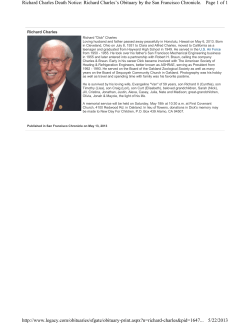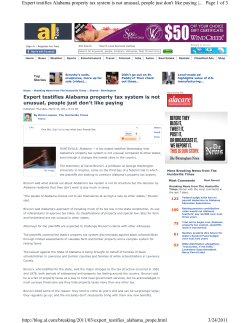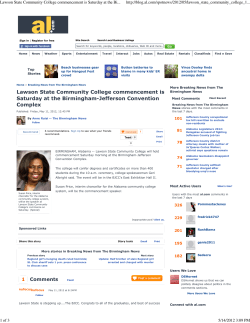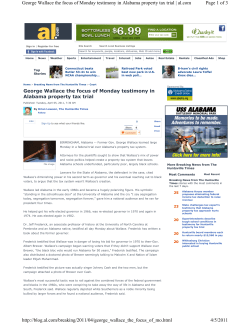
UAB MHRC Inaugural Gala a Total Success
WINTER 2006 UAB MHRC Inaugural Gala a Total Success The September 30 black-tie reception and dinner at the Wynfrey Hotel in Birmingham, hosted by former NBA all-star Charles Barkley, drew some 525 attendees—twice the original goal—and raised more than $150,000 to support the MHRC’s efforts to eliminate health disparities among Alabama’s minority citizens. Among guests were Barkley’s mother, Charcey Glenn of Leeds, and Lucille O’Neil, mother of NBA superstar Shaquille O’Neil. For the first time UAB offered the Norm Davis, Mona Fouad, Carol Garrison, Charles Barkley, Cathy Freidman, Selwyn Vickers and Edward Partridge the funds donated by Barkley. Edward thanked Barkley for his vision. Disparities Partridge, MD, co-director of the MHRC, Barkley’s generous gift to the MHRC Research Awards made possible through called the gala “an amazing event” and kick-started the gala and provided funds for Charles Barkley Health (continued on page 3) No Boundaries Alabama Black Belt and the Mississippi Published in The Birmingham News Sunday, September 25, 2005 MONA FOUAD, MD, MPH Delta. Consider these New Orleans statistics, before the disaster: 28 percent of the peo- On a good day, people living in poverty ple are living below the poverty level, and have little or no access to health care and the per-capita income is $13,400; 70 per- few resources to help them cope. Can you cent of the population are African imagine their misery in the wake of one of (continued on page 2) the largest disasters in U.S. history? IN THIS ISSUE As my eyes and ears filled with images and sounds out of the poorest part of New Orleans, the frustrated, desperate stares of Take away the floodwaters and the strand- young and old reminded me that poverty ed mothers and children, switch gritty creates the same conditions everywhere. urban for red-dirt rural—and you are in the MINORITY HEALTH & RESEARCH CENTER | WINTER 2006 • MHRC Inaugural Gala • No Boundaries • MHRC Hispanic/Latino Working Group • Coming Events B U I L D I N G T R U S T, S H A R I N G P O W E R , A N D E L I M I N A T I N No Boundaries (continued from page 1) American and other minorities; and 28 percent of those 5 years and older have a physical disability. Where you see statistics like these, you portionately represented in the people liv- neighbors, carrying health-promoting mes- ing below the poverty line, Alabama and sages to their communities through other Deep South states have an enor- churches, exercise classes, and other ven- mous challenge in bringing better health to ues. Many units at UAB are involved in the them. Our mission at the UAB Minority overall outreach to poor communities; for Health and Research Center is to find ways example, the School of Dentistry is the top to improve their health. provider of dental care to Alabama almost always also see lack of transportation, high unemployment, low education, low rate of health insurance, and high disease burden (diabetes, cancer, hypertension, etc.). On top of that, the high rate of uninsured people, combined with other factors, keeps doctors and other health-care professionals, not to mention clinics and hospitals, from establishing practice locations in the region. For example, in Lowndes County, there are only 4 doctors per 10,000 people. Some counties don’t have adequate 911 systems, emergency response plans, ambulances, or trained emergency person- The work is almost overwhelming, but Medicaid patients. The School of Nursing is the past few years have shown some posi- using a federal grant to prepare nurse prac- tive change in the efforts to improve health titioners to deliver primary care in rural care and other indices of poverty in the areas. There is much more work to be Black Belt and elsewhere. Some eyes have done, sleeves to be rolled up, and purpose- been opened to the poverty of the area and ful action to be taken by a united phalanx of how it drags down Alabama’s economy people who share a commitment to lift the and afflicts our hearts. Federal money has burdens of those among us who are poor. been found to fund entities such as UAB’s We have seen in the media spotlight the Minority Health and Research Center. Gov. horrific results of a disaster exacerbated by Bob Riley and U.S. Rep. Artur Davis, D- poverty. If there is one silver lining from the Birmingham, among others, are trying to terrible storm clouds, it is that the citizens bring forces to bear on the problem by of the United States have seen the poverty establishing the Black Belt Action that exists in our own country, not just in Commission. faraway places, and have been moved to Private citizens have stepped up, too, action. We must now move beyond the dis- among them Alabamian Charles Barkley, aster to repair the Gulf Coast damage. And the former NBA all-star. Upon hearing the we must also plan and act to prevent other For many years, I have seen the face of stark statistics of poor health among our tragedies by addressing the poverty in the poverty in my work as a doctor here and region’s minorities and how that diminish- Black Belt and elsewhere in Alabama. abroad. I’ve been intimately involved in es everyone’s prospects, Barkley donated a Good health, woven into a matrix like a studying the conditions that are present in considerable sum toward ending these dis- supportive basket, is a significant basis of poor communities and regions in Alabama parities and signed up as spokesperson for hope, for it leads to jobs, to the ability of and across the South. I have catalogued our efforts. The Barkley Health Disparities people to be self-sustaining, and to the abil- the conditions, listened to the troubles, and Initiative at UAB supports research into ity—when disaster does play its stunningly given myself over almost to despair about these problems and funds hands-on pro- capricious hand—for them to withstand the how to deal with and improve the straits of grams to address them. blows and to pick themselves up from the nel. This further illustrates the magnitude of health-provider shortage in rural Alabama. poverty. UAB has more than 20 collaborative wreckage afterward to recover, repair, rebuild, and move forward. I found out that poor people cannot programs in the Black Belt, addressing afford to get sick. But, unfortunately, they stroke, hypertension, glaucoma, diabetes, Mona N. Fouad, MD, MPH is professor do get sick. It is almost axiomatic that peo- and other diseases. We and our partners and director of UAB’s Minority Health and ple in poverty are in worse health than the have trained more than 1,000 community Research Center. E-mail: mfouad@uab.edu. rest of us. As African Americans are dispro- members to be health advisers to their MINORITY HEALTH & RESEARCH CENTER | WINTER 2006 page 2 I N G R A C I A L A N D E T H N I C B I A S A N D D I S C R I M I N AT I O N UAB MHRC Inaugural Gala a Total Success (continued from page 1) three research grants designed to promote companies, foundations, and individuals research in health disparities and encour- joined the effort at the $5,000 Leader, age young investigators and junior faculty $2,500 Supporter, and $1,000 Sir to pursue careers in minority-health Charles’ Court levels. research. UAB president Carol Z. Garrison, who MHRC co-director Selwyn M. Vickers, introduced Barkley at the dinner, lauded MD said, “These awards highlight the the MHRC for bringing together 200 facul- excellence in research by minority investi- ty scientists who have attracted more than gators and provide a forum for us to be $22 million in funding. “With this team, mentors and show to ourselves and the and in partnership with the community and community that minority does not mean Monica Baskin, PhD, Department of Health Behavior, School of Public Health, received award for her work “Childhood Obesity Intervention at the Chris McNair Health Department.” mediocrity.” Event co-chairs Norman B. Davis Jr., Executive Vice President of First American West Alabama, including the Black Belt. Bank, and Cathy O. Friedman of City Paper That region of the state brings into sharp Company headed a host committee of 30 focus the compelling need for better leaders from UAB and the local community access to health care for all Alabamians. in an effort to secure financial support for MHRC director Mona N. Fouad said, the MHRC’s mission. Alabama Power “We are extremely gratified by this success. Company provided lead sponsorship at the It gives us a great base to build upon for $10,000 Champion level. Numerous other future years as we create the pipeline of Jamy Ard, MD, Department of Nutrition Sciences, received award for his work “Enhancing Weight Loss Outcomes in African Americans Using a Modified Eat-Right Approach.” minority professionals in the biomedical fields.” the state, they are working together to dispel health disparities in the state, the region, and nationally,” she said. Other speakers included the Honorable Congressmen Artur Davis, who represents Alabama’s Lucy Annang, PhD, Department of Health Behavior in the UAB School of Public Health, received award for her work “Peer Education to Promote Sexually Transmitted Infection Prevention among Young Adult African American Women.” page 3 Seventh Congressional District, which covers parts of Birmingham as well as much of Central and Charles Barkley, UAB MHRC spokesperson and Gala Chair, congratulates some of the investigators who won Minority Research Day awards. MINORITY HEALTH & RESEARCH CENTER | WINTER 2006 B U I L D I N G T R U S T, S H A R I N G P O W E R , A N D E L I M I N A T I N Minority Health & Research Center Charles Barkley Inaugural Gala Charles Barkley with Mr. and Mrs. Gerald Johnson Lucille O’Neal and Charcey Glenn “This gala is just the first of many to further the Center’s efforts to improve the health status of minorities throughout our state, region, and nation. UAB has a very strong commitment to closing the gap in health disparities by conducting leading-edge research, by working at the grassroots level with underserved communities, and by educating and mentoring promising minority students who are future physicians and researchers. The MHRC is at the vanguard of these efforts.” Dr. and Mrs. Isaac Ravizee, Charles Barkley, and Dr. and Mrs. Norman Walton - Carol Garrison President, University of Alabama at Birmingham Charles Barkley with Joanice Thompson, Yvette Spencer, and Dr. Sharon Spencer Charles Barkley with Dr. and Mrs. Eli Capilouto Charles Barkley with Mr. and Mrs. Earl Foust Charles Barkley with President Garrison and Cathy Friedman Mr. and Mrs. Norm Davis with President Garrison “I am very blessed, I have had a great life. But I think fame is really overrated… I do. You say to yourself… you get famous, you get a lot of money… then you realize there are more important things in life… So I thank God for the life I have but I understand that it is not about being famous and rich. You are blessed with a special gift and you are supposed to make great things with that… This is a great time in my life.” Dr. and Mrs. Selwyn Vickers, Charles Barkley, and Dr. and Mrs. Kirby Bland - Charles Barkley, MHRC spokesperson MINORITY HEALTH & RESEARCH CENTER | WINTER 2006 Dr. Edward Partridge page 4 I N G R A C I A L A N D E T H N I C B I A S A N D D I S C R I M I N AT I O N Cathy Friedman and Norm Davis, Gala co-chairs Master of Ceremony, Linda Mays U.S. representative Artur Davis Charles Barkley with Mona Fouad “We need to reach out to our communities to work together with them, build their capacity, give them the knowledge, the skills, and empower them so that they have health as a top priority. Your support is very important. This is not just a UAB Center. We want it to be your Center. Take ownership of it and take this opportunity and use it as a venue to help your underserved communities. Give us your feedback and let us know how we can work together to improve the health of our communities.” Dr. Mona Fouad - Mona Fouad Director, UAB Minority Health and Research Center Charles Barkley with Dr. Louis Dale and Dr. Annice Yarber Charles Barkley with Angela Williams (mother and daughter) Dr. Shirley Salloway Kahn and Charles Barkley Bob and Virginia Loftin with Charles Barkley Charles Barkley and Mr. Mark Jerald Charles Barkley and Mrs. Andria Hurst Dr. John Amos with Charles Barkley page 5 Dr. and Mrs. Hernan Moreno and Dr. and Dr. Alejandro Aldana with Charles Barkley MINORITY HEALTH & RESEARCH CENTER | WINTER 2006 B U I L D I N G T R U S T, S H A R I N G P O W E R , A N D E L I M I N A T I N Special Thank You to Our Sponsors Gala Pictures Champion (continued from pages 4 and 5) Alabama Power Company Foundation Hughes Capital Management Jefferson County Committee on Economic Leaders Birmingham News First American Bank McWane, Inc. Protective Life Foundation Raymond James & Associates, Inc. UAB Administration UAB Department of Medicine Opportunity Jon and Sheryl Kimerling KHAFRA Publix Super Markets Charities Mr. Gerald Johnson Turner Sports Network UAB Health System UAB School of Health Related Professions UAB School of Social and Behavioral Sciences UAB Department of Obstetrics and Gynecology UAB Department of Surgery Vines & Waldrep, LLC UAB School of Dentistry Mr. Anthony Barnes UAB School of Medicine Volkert and Associates Vulcan Materials Company Supporters Wachovia Securities, LLC Dr. Norman W. Walton III Alabama Gas Corporation American Cast Iron Pipe Corporation BellSouth Brasfield & Gorrie, LLC Bruno Event Team Sir Charles’ Court Doris Strode and Judge John England with Charles Barkley Mr. and Mrs. Earl Foust Dr. Sharon Spencer Buffalo Rock Company Citizens Trust Bank Special Thanks City of Leeds ABC 33/40 Daniel Corporation FitzMartin Advertising Drummond Company, Inc. The Birmingham News FitzMartin Advertising The UAB Events Staff Haskell Slaughter Young & Rediker, LLC MINORITY HEALTH & RESEARCH CENTER | WINTER 2006 Mr. and Mrs. Loder and Gail Cunningham The MHRC Gala pictures published in this newsletter and many more are posted on the MHRC website. Pictures can be viewed online and prints can be ordered at www.uabmhrc.com. Go to GALA on the home page. page 6 I N G R A C I A L A N D E T H N I C B I A S A N D D I S C R I M I N AT I O N The MHRC Hispanic/Latino Working Group Celebrates Two Years of Growth “The UAB Minority Health and Research Program for Latinas; and HPV Vaccine discussing research ideas and assisting Center celebrates the important develop- Acceptability: an Exploratory Study. with grant submissions, writing, and statis- ment and growth of its Hispanic/Latino Most of the above studies have identi- tical support. Working Group, an MHRC initiative that fied a number of health needs as well as Members started in January 2003 under the leader- barriers to health care among Latinos in Working Group have also been involved in ship of Isabel Scarinci, PhD, MPH and Alabama, and the findings are being the Career Development Support Group Graciela Alarcon, MD, MPH with the partic- shared with faculty in the Hispanic/Latino organized by Dr. Mona Fouad, where they ipation of the UAB Hispanic/Latino faculty Working Group. have given monthly presentations on cur- and faculty interested in Hispanic/Latino of the Hispanic/Latino The group has promoted recruitment rent research efforts. An abstract regarding and training of bilingual investigators and the group as an example for academic part- staff by sharing research priorities with nerships was accepted for presentation at deans and administration. A number of the annual meeting of the American Public resources, such as Spanish-translated Health Association in November, 2005 The group composed of 55 faculty measures, new research findings, funding under the title “Latino/Hispanic Working members meets monthly to discuss opportunities, and useful references, are Group: an Academic Solution to Respond progress under its three programmatic continually posted on the MHRC website, to goals of research, training, and community www.uabmhrc.com, and sent to MHRC Latino/Hispanic Immigrants.” outreach. members through eNews. issues from all disciplines and schools across campus,” says Mona Fouad, MD, MPH, Director of the UAB Minority Health and Research Center (MHRC). Emerging Health Needs of The group promotes sensitivity in deal- In the field of research, the group identi- One of the main priorities of the ing with the Latino community and aware- fied 11 current research projects at UAB Hispanic/Latino Working Group has been ness of its needs, preferences, and culture. that focus on Hispanics/Latinos. Among to develop the pipeline of Hispanic stu- During the past year a number of presenta- these are LUMINA (LUpus in MInorities: dents at UAB. Under the training goal, the tions on Hispanic culture and health needs NAture versus Nurture), by Dr. Graciela group has established a mentorship pro- were given around campus, among them a Alarcón; Child Health Needs of Rural gram for Hispanic/Latino freshman stu- presentation by Drs. Scarinci and Saenz to Alabama Latino Families, by Dr. Lynda dents. The program, MANOS JUNTAS, students and faculty in the Department of Harrison; Latino held its inaugural meeting to match 19 Pediatrics and a presentation before the Community: Attitudes, Beliefs, and a Plan UAB freshman students who self-identified School of Dentistry Grand Rounds by Dr. of Action, by Dr. Jewell Halanych; AMERI- as Hispanics with 19 faculty members who Scarinci. CO (Admixture Mapping for Ethnic and volunteered to mentor these students An exchange visitor program between Racial Differences on Insulin Complex throughout college. In addition the group UAB and investigators from Central and Outcomes), by Dr. José Fernandez; and compiled a list of South America has been another achieve- Barriers to Seeking Further Eye Care after the school systems ment of the Hispanic/Latino Working Vision Screenings in Hispanic Children in across the state of Group. Hispanic Research Fellows, among Jefferson County, by Dr. Marcela Frazier. Dr. Alabama with a them Dr. Rosa Andrade from Peru and Dr. Isabel Scarinici has several research proj- large number of Mónica Fernandes from Mexico, have ects: Cervical Cancer Screening in Hispanics. been recruited to work on the LUMINA Diabetes and the Hispanics; Cervical Cancer Prevention in Through the MHRC the Hispanic/Latino study. Previous trainees have come from Latina Immigrants; Sowing the Seeds of Working Group has been instrumental in Argentina (Dr. Ann Bertoli) and Spain (Dr. Health: a Program for Lay Health the development and support of a number Janine Calvo Alén). From July to Promoters; Sowing the Seeds of Health: a of Latino-focused research proposals by (continued on page 8) page 7 MINORITY HEALTH & RESEARCH CENTER | WINTER 2006 Coming Events Hispanic/Latino Working Group (continued from page 7) December, 2005 the group hosted Dr. and training in issues related to them,” said Andréa F. Silveira, a visiting scholar from Scarinci. the Pontifícia Universidade Católica do Paraná, Brazil. about Latino health issues, Dr. Scarinci has Understanding the importance of involv- given lectures about Hispanic culture and ing community leaders for the success of Latino health needs to social services agen- community outreach initiatives, the group cies, health departments, Birmingham identified leaders in the Latino community Leadership Program, local funders, etc. and established collaborations. One such September 29, 2006 MHRC Charles Barkley Gala 2006 www.uabmhrc.com To promote education and awareness Members of the Hispanic/Latino example is the training of “natural Working Group volunteered their time to helpers/leaders” in the Latino community provide health information in a monthly to be lay health promoters. The program radio show organized by the lay health pro- was developed as a partnership between moters. Every month two local Latino news- the MHRC and St. Vincent’s Hospital. papers publish a health-related article free “We have collaborated with local hospi- of charge; some of the articles are written tals and clinics in Latino-targeted outreach by members of the Hispanic/Latino activities (e.g., breast and cervical screen- Working Group. Finally, Dr. Karen Saenz ing, raising awareness of skin cancer and provides health education and nursing serv- sexually transmitted infections) to support ices to low-income Latinos one day per the Latino community with information week at the Multicultural Center in Hoover. Non-profit Org. WINTER 2006 U.S. Postage PAID Permit No. 1256 Birmingham, AL Minority Health and Research Center The University of Alabama at Birmingham 1530 3rd Avenue South, MT618 Birmingham, Alabama 35294-4410 (205) 996-2880 info@uabmhrc.com www.uabmhrc.com Editor in Chief: Mona Fouad, MD, MPH Associate Editors: Edward Partridge, MD Selwyn M. Vickers, MD Managing Editor: Maria Claudia Norena Contributors: Denise Bristow Randi Gilinson Cynthia Gilliom Ann Smith Joanice Thompson PS-15654
© Copyright 2025

















